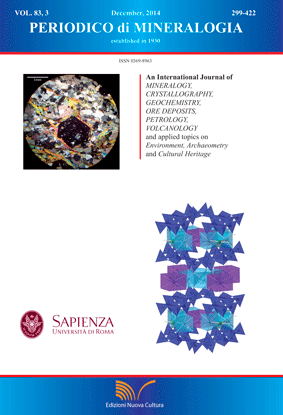Crystallisation from a melt and crystallisation at subsolidus conditions: comparison from CSDs study on Gennargentu Rocks (Sardinia, Italy)
DOI:
https://doi.org/10.2451/2014PM0022Keywords:
Crystal size distributions, Gennargentu Igneous Complex, plagioclase, subsolidus crystallisation, Ostwald ripeningAbstract
Crystal size distributions (CSDs) has been constrained in plagioclase and cordierite in quartz-diorite and migmatites. Euhedral plagioclase crystals in a plutonic body preserve the crystallisation processes that occurred during the cooling history of the body. A crystallisation from a liquid (i.e. plagioclase crystals in quartz diorite and in migmatite leucosomes) has been compared with a crystallisation at subsolidus conditions (i.e. plagioclase and cordierite crystals in contact metamorphic rocks). At contact with the metamorphic basement the texture is migmatitic. Plagioclase CSDs have been investigated in a plutonic body (i.e. quartz diorite), in the leucosome of migmatites and in the melanosome of un-melted contact metamorphic rocks from Gennargentu Complex (Sardinia, Italy). Cordierite CSDs have been investigated only in the hybrid rocks of the same complex. CSDs indicate that, initially, plagioclase crystals in the quartz diorite nucleated and grew in a cooling system at a constant cooling rate, producing a straight-line crystal size distributions. The plagioclase crystallisation continued until the latent heat was available and the temperature was high enough to allow the plagioclase growing. When the temperature was low enough to reach the solidus temperature of plagioclase crystals, the nucleation was inhibited and the conditions were suitable for a textural coarsening (Ostwald ripening process). The small crystals, due to their high surface energy per unit volume dissolved and “fed” the growth of larger crystals. Moreover, the maintenance of temperature near the plagioclase liquidus may also inhibit the nucleation and growth of other phases. Cordierite crystals from contact metamorphic rocks show a similar behaviour, while the plagioclases from the migmatites show an accumulation process. From CSDs measurements we were able to calculate the different cooling ages for the different sample types as following: dark quartz diorite samples crystallise in an average of time of 5000 years; the light quartz diorite shows a slow cooling (average of 7300 years).


